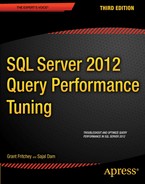Book Description
Queries not running fast enough? Tired of the phone calls from frustrated users? Grant Fritchey's book SQL Server 2012 Query Performance Tuning is the answer to your SQL Server query performance problems. The book is revised to cover the very latest in performance optimization features and techniques. It is current with SQL Server 2012. It provides the tools you need to approach your queries with performance in mind.
SQL Server 2012 Query Performance Tuning leads you through understanding the causes of poor performance, how to identify them, and how to fix them. You'll learn to be proactive in establishing performance baselines using tools like Performance Monitor and Extended Events. You'll learn to recognize bottlenecks and defuse them before the phone rings. You'll learn some quick solutions too, but emphasis is on designing for performance and getting it right, and upon heading off trouble before it occurs. Delight your users. Silence that ringing phone. Put the principles and lessons from SQL Server 2012 Query Performance Tuning into practice today.
Establish performance baselines and monitor against them
Troubleshoot and eliminate bottlenecks that frustrate users
Plan ahead to achieve the right level of performance
What you'll learn
Establish performance baselines and monitor against them
Recognize and eliminate bottlenecks leading to slow performance
Deploy quick fixes when needed, following up with long term solutions
Implement best-practices in T-SQL so as to minimize performance risk
Design in the performance that you need through careful query and index design
Take advantage of the very latest performance optimization features in SQL Server 2012
Who this book is for
SQL Server 2012 Query Performance Tuning is aimed at developers and database administrators having responsibility for application performance in SQL Server environments. Programmers and administrators alike will find the book a trove of good insight into bottlenecks, how to recognize them, how to eliminated them. SQL Server 2012 Query Performance Tuning provides the tools and techniques readers need to create good-performing applications that delight their users.
Table of Contents
- Title Page
- Contents at a glance
- Contents
- About the Author
- About the Technical Reviewer
- Acknowledgments
- Introduction
- CHAPTER 1: SQL Query Performance Tuning
- CHAPTER 2: System Performance Analysis
- Performance Monitor Tool
- Dynamic Management Objects
- Hardware Resource Bottlenecks
- Memory Bottleneck Analysis
- Additional Memory Monitoring Tools
- Memory Bottleneck Resolutions
- Disk Bottleneck Analysis
- Additional I/O Monitoring Tools
- Disk Bottleneck Resolutions
- Processor Bottleneck Analysis
- Other Tools for Measuring CPU Performance
- Processor Bottleneck Resolutions
- Network Bottleneck Analysis
- Network Bottleneck Resolutions
- SQL Server Overall Performance
- Considerations for Monitoring Virtual Machines
- Creating a Baseline
- Summary
- CHAPTER 3: SQL Query Performance Analysis
- CHAPTER 4: Index Analysis
- CHAPTER 5: Database Engine Tuning Advisor
- CHAPTER 6: Lookup Analysis
- CHAPTER 7: Statistics Analysis
- CHAPTER 8: Fragmentation Analysis
- CHAPTER 9: Execution Plan Cache Analysis
- CHAPTER 10: Query Recompilation
- CHAPTER 11: Query Design Analysis
- CHAPTER 12: Blocking Analysis
- Blocking Fundamentals
- Understanding Blocking
- Locks
- Lock Operations and Modes
- Isolation Levels
- Effect of Indexes on Locking
- Capturing Blocking Information
- Blocking Resolutions
- Partition the Contended Data
- Recommendations to Reduce Blocking
- Automation to Detect and Collect Blocking Information
- Summary
- CHAPTER 13: Deadlock Analysis
- CHAPTER 14: Cursor Cost Analysis
- CHAPTER 15: Database Performance Testing
- CHAPTER 16: Database Workload Optimization
- CHAPTER 17: SQL Server Optimization Checklist
- Index
